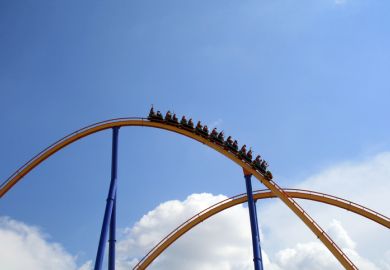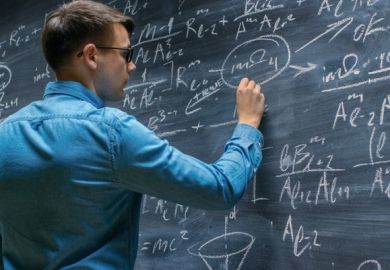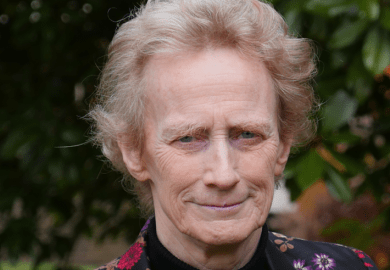Time may be something we are able to keep to the millionth of a second but travel through is still eludes us. Julian Barbour looks at Einstein's lasting problem.
Few intellectual struggles have been greater than Einstein's from 1912 to 1915, when he created his general theory of relativity. Relativity and quantum mechanics are now the twin foundations of science: cosmology, metrology (the subject of The Measurement of Time under review), optics, nuclear physics and much more. But Einstein's work catches the imagination above all because it touches so intimately, deeply and mysteriously the notion of time. Does anyone know how many popular-science books about time and relativity have been published? Einstein himself initiated the genre in 1916 with Relativity , which still sells well. Paul Davies and J. Richard Gott have now added two more - on time machines.
The first hint that time travel into the past might be possible came in an article Einstein wrote in 1914: " A priori one can conceive a motion of a point such that the four-dimensional curve of its motion is almost closed. In this case, one and the same material point could be present in many seemingly independent instantiations in an arbitrarily small space-time region. This runs quite counter to my physical intuition. But I cannot prove that such curves are ruled out in the theory being developed."
Einstein had clearly recognised the basis of the time machine that Davies, only slightly tongue in cheek, tells us how to build. He essentially defined a closed time-like curve (CTC), in which even humans can in principle cycle back into their past an unlimited number of times. I am not aware that Einstein's four sentences tucked away in a long technical article - which was soon superseded by the definitive theory - made any real impact for the next 35 years. But in 1949 Kurt Gödel, the great logician, mathematician and friend of Einstein at the Institute for Advanced Studies in Princeton, published an actual solution of Einstein's equations in which CTCs abound. This paper had a significant influence on the mathematical advances that were soon, shortly after Einstein's death in 1955 and in conjunction with the experimental developments described here by Claude Audoin and Bernard Guinot, to transform general relativity. From a greatly admired but largely ignored intellectual creation, it became the modern foundation of physics and metrology. Godel's paper also gave a great boost to books on time travel.
Both of the latest additions can be recommended. Davies is a reliable and prolific writer of popular-science books. This is his third on time. He and Gott are not science journalists but respected scientists in their own right. Gott, in fact, discovered one of the known mechanisms that create CTCs in Einstein's theory and therefore could in principle be used to build a time machine. Davies's How to Build a Time Machine is slim but not slight and is none the worse for its cartoon illustrations, which are now rather in vogue. Gott's Time Travel in Einstein's Universe , which is refreshingly sober in tone, is longer. It includes a mechanism elaborated by Gott and his young Chinese collaborator Li-Xin Li whereby a spontaneously created CTC spawns our universe with the assistance of quantum mechanics. This is one of those proposals that reviewers are wont to call ingenious. It does have merit, but one wants to express some scepticism politely. For myself, I doubt if it is the reason why we are here.
Lest readers should think time machines are likely to become technically feasible in the near future, they are not, as both Davies and Gott make clear. At best they are very remote possibilities. Gott gives the real scientific reason for working on such exotica. Many advances in science come from exploring as far as one can all implications of a good theory. One must push it to its limits. This is why time travel is now cutting-edge theoretical research. But the real thing will not happen tomorrow.
And, at the risk of being a thorough spoilsport, I doubt if it ever will. I base this hunch on "the boring-physics conjecture", as time-travel theoretician Matt Visser called it in January at the conference to mark Stephen Hawking's 60th birthday. Einstein's theory in its original space-time form allows a superabundance of solutions that many would gladly "thin down" by some principle. In the 1950s Britain's Paul Dirac and the Americans Richard Arnowitt, Stanley Deser, and Charles Misner (known as ADM) found an alternative, more traditional way to describe Einstein's theory. It employs dynamical methods with a venerable tradition stretching back to Newton. In this formulation, all the exotic solutions of general relativity that run so counter to Einstein's intuition are simply not allowed. They do not fit the standard dynamical format. The boring-physics conjecture is that it is the Dirac-ADM formulation rather than the space-time picture that describes nature. If this is correct, Visser, who considers the conjecture seriously, will have to change his research field. I find more and more arguments for a return to "the royal highroad of dynamics" (the phrase is due to John Wheeler, who also coined the expression black hole). Space-time might be a glorious historical accident. But this is very much a minority view.
Barry Dainton's Time and Space is a very different book, though it too dabbles in time travel. He is a lecturer in philosophy at the University of Liverpool, and his book is written mainly for students of the philosophy of science. This is an increasingly popular subject at many universities, and I think his book may well be successful with them. Dainton mostly writes well, but I cannot give his book a wholehearted recommendation. This has less to do with Dainton than with the whole discipline. Though some do fine work, philosophers of science spend a lot of time arguing with each other about issues that with the best will in the world have little to do with science.
A classic example is the so-called substantivalism versus relationism debate, which features prominently in Dainton's book. This goes back to a famous exchange in 1715/16 between Leibniz, co-creator of the calculus with Newton, and Samuel Clarke, who was Newton's mouthpiece. The Leibniz-Clarke correspondence on the nature of space, time and motion is included in many philosophy courses. It is almost as much a staple for them as is time travel for popular science. The topic is surely important. The trouble with many philosophers of science is that they fail to identify the real issues. Swaths of their writings, Dainton's included, are devoted to different ways in which one might conceive things without there being the remotest chance of one's ever finding a way of testing which of the different ways is better. It is just manipulation of words that never gets to a point of substance.
When he does come to real issues, Dainton is not as accurate as one could wish. In fact, on two occasions he has picked up, unacknowledged, ideas of my own and rather mangled them. (The "spaghetti" diagrams on page 195 appear to be copied from my book The End of Time .) I am sure this is merely an oversight, since he does cite and discuss other work of mine.
The Measurement of Time is certainly the most valuable of these four books. It should be on the shelf of any working scientist who takes a pride in the foundations of his or her work. Although at times uneven in clarity of expression, it is an invaluable guide for workers in many disciplines, including metrology, theoretical physics, oceanology, geology, communications, space exploration and navigation, to name but a few. Einstein's influence is felt on almost every page of the book. Stephen Lyle has made an excellent translation from the original French.
Metrology is a subject that many feel lacks glamour, but it is the basis of science. To their great credit, this is something the French have long recognised. They did splendid pioneering work in the 18th century as part of the Enlightenment. Paris is home to the Bureau International de l'Heure. Audoin is the expert on atomic clocks, Guinot on astronomical time. I wonder whether the writing of the book led to tussles between the two. They tell the epic story of how the creators of atomic clocks managed to wrest the bulk of time-keeping responsibilities - which are great - from the astronomers. The turning point came in 1967, when the second, now by far the most accurately determined fundamental unit in science, was defined in atomic terms. It is worth quoting the exact words: "The second is the duration of 9 192 631 770 periods of the radiation corresponding to the transition between the two hyperfine levels of the ground state of the caesium-133 atom."
Without accurate measurement, almost nothing can be done in science. The atomic clock is one of the glories of the 20th century. For work directly connected with its development, about nine scientists were awarded the Nobel prize. The study of the binary pulsar, with its spectacular confirmation of numerous predictions of Einstein's general relativity, would have been unthinkable without the caesium beam clock. For it, Joseph Taylor and Russell Hulse also won the Nobel. I would gladly have written much more about such an absorbing story.
Instead, let me quote some figures. Thanks to the atomic clock, distances around the world and to the Moon are now routinely measured to 1 or 2cm. But still the metrologists worry. Over a period of 30 years, their clocks may go wrong by about one third of one millionth of a second! The point at which the Earth's rotation axis pierces its surface wanders in a period of about 18 months around an irregular curve that strays up to about 18m from the mean position (the Chandler wobble). Unless Nasa knows its instantaneous position with great precision, space probes would miss distant targets in the solar system. (The Earth serves as the frame of reference.) The pole's position, monitored by a mixture of theory and continuous measurement, is currently established to within 1.5mm. Monitoring of seismically active regions of the Earth's surface with this sort of accuracy may soon help with earthquake prediction.
I end with the regret that Audoin and Guinot do not devote more space to the conceptual definition of clocks and do not emphasise the importance in their design of solids, which furnish rods. Rods and clocks are the basis of metrology. Rods are not given their due.
Julian Barbour is the author of The End of Time (1999) and The Discovery of Dynamics (2000) and is currently working with collaborators on gravitational dynamics.
Time and Space
Author - Barry Dainton
ISBN - 1 902683 32 3 and 33 1
Publisher - Acumen
Price - £45.00 and £18.95
Pages - 386
Register to continue
Why register?
- Registration is free and only takes a moment
- Once registered, you can read 3 articles a month
- Sign up for our newsletter
Subscribe
Or subscribe for unlimited access to:
- Unlimited access to news, views, insights & reviews
- Digital editions
- Digital access to THE’s university and college rankings analysis
Already registered or a current subscriber? Login


